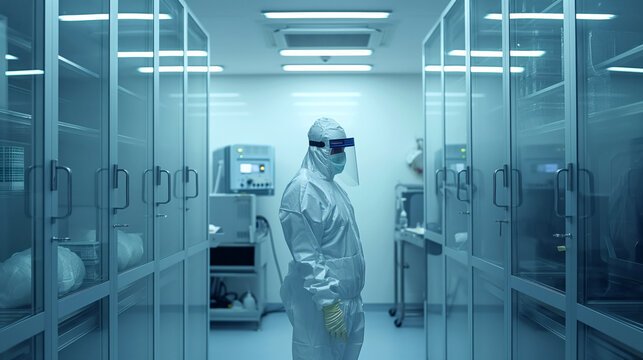Personal Protective Equipment (PPE) has become a necessity for healthcare workers and researchers alike. In a laboratory setting, PPE is essential to reduce the risk of exposure to hazardous chemicals, infectious agents, and other dangerous materials. In this article, we will discuss the PPE used for laboratory work.

Lab Coats and Gowns
Lab coats are a common type of PPE worn by laboratory workers. A lab coat provides a layer of protection against chemical splashes and other hazardous materials. They are usually made of cotton, non woven, polyester, or a combination of both. Lab coats can be tailored to fit the wearer’s body and come in a range of sizes.
Gowns are often used in more specific laboratory settings, such as operating rooms or cleanrooms. These gowns are designed to be impermeable to fluids and prevent the spread of infections. They are typically made of polyester material and can be disposable or reusable depending on the type of lab work being performed.
Gloves
Gloves are another essential type of personal protective equipment used in laboratory settings. Gloves protect the wearer from exposure to toxic or infectious materials. Gloves come in various materials such as latex, nitrile, and vinyl. Each material has its own properties, and the type of glove needed depends on the specific task being performed.
For instance, if the job involves exposure to toxic or hazardous materials like chemicals or infectious agents, the material must be impermeable to these materials (e.g., nitrile or latex). In contrast, if the job involves lighter work, like handling lab equipment, disposable vinyl gloves might be more appropriate.
Safety Glasses
Safety glasses are often used in the laboratory to protect the eyes from chemical splashes and other hazardous materials. These glasses have thick lenses that can withstand impact, and they offer a secure fit to prevent them from slipping off during regular use.
As with other types of PPE, there are different types of safety glasses suitable for different laboratory tasks. Depending on the job being done, loupes (magnifying glasses), or safety goggles capable of sealing off the eyes may be required.
Respirators
Respirators are vital for ensuring the safety of laboratory workers exposed to dangerous chemicals, particles, or fumes. There are two types of respirators: air-purifying respirators (APRs) and supplied-air respirators (SARs).
Air-purifying respirators (APRs) filter or clean the air before it is breathed in, and they come in half or full-face masks. These respirators are best suited for environments with lower levels of toxic material.
Supplied-air respirators (SARs) provide clean air directly to the wearer through a hose connected to a separate air source. These respirators are best suited for environments with higher levels of toxic material.
Footwear
Footwear may seem like a minor type of PPE, but choosing appropriate shoes is critical for laboratory safety. Laboratory shoes must be slip-resistant, comfortable, and most importantly, have closed toes and non-porous soles. This helps prevent injuries from spilled chemicals or dropped objects and protects the feet from chemical or biological hazards.
Other PPE
The PPE listed above is not an exhaustive list; there are other types of PPE used for laboratory work. For instance, face shields, aprons, and full body coveralls are often used in specialized laboratory settings. Face shields protect the face from chemical splashes or flying debris. Aprons and coveralls provide an additional layer of protection against toxic or hazardous substances.
How to Use PPE
One thing laboratory workers need to understand is that PPE alone is not enough. Proper use and disposal of PPE are equally as important. Before using PPE, it is essential to undergo training on its proper handling and usage. This applies to all types of PPE, not just laboratory settings.
The PPE must be stored and maintained appropriately to ensure its effectiveness during use. Once used, PPE needs disposal according to the appropriate disposal guidelines.
Furthermore, laboratory workers need to know when to use PPE. PPE should be used whenever there is a risk of exposure to harmful substances or infectious agents. It is the responsibility of the laboratory manager to ensure that PPE is readily available, appropriately stored, and replaced frequently to maintain its integrity.
PPE is crucial for maintaining safety in laboratory settings. Laboratory workers need to be aware of the types of PPE available, their specializations, and when to use them. PPE should be regarded as the last line of defense to protect laboratory personnel, and proper usage, maintenance, and disposal protocols should be respected at all times. Ultimately, the use of PPE is a shared responsibility between laboratory workers and management, and effective implementation of PPE protocols will help minimize the risks associated with laboratory work.


